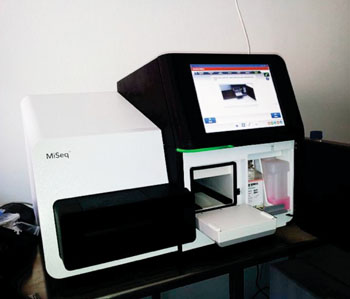Healthy-Looking Prostate Cells Mask Cancer-Causing Mutations
By LabMedica International staff writers
Posted on 19 Mar 2015
Genome-wide DNA sequencing has been used to decrypt the phylogeny of multiple samples from distinct areas of cancer and morphologically normal tissue taken from the prostates of individuals.Posted on 19 Mar 2015
Prostate cancer is often made up of many small tumors with different genetic fingerprints, and it is still unclear what causes these different tumors to develop in the prostate at the same time, but new studies provides a piece of the puzzle that could help solve the mystery.

Image: The MiSeq desktop sequencer (Photo courtesy of Konrad Förstner).
A large team of scientists led by the Institute of Cancer Research (London, UK) collected samples for analysis from prostatectomy patients. Prostates were sliced and processed and a single 5-mm slice of the prostate was selected for analysis purposes, and 4-mm or 6-mm cores were taken from the slice and frozen. Frozen cores were mounted vertically and sectioned transversely to create one 5-μm frozen section for staining and six 50-μm sections for DNA preparation.
The V-Ets Avian Erythroblastosis Virus E26 Oncogene Homolog (ERG) fluorescence in situ hybridization (FISH) break-apart assay for assessing ERG gene rearrangement was performed. DNA was extracted from 18 samples from three subjects: 12 prostate cancer samples; three adjacent, morphologically normal prostate samples; and three matched bloods. Paired-end genome-wide sequencing (GWS) of the samples was also performed. Targeted polymerase chain reaction (PCR) and sequencing of selected mutations and structural variants were analyzed for each sample using a MiSeq sequencer (Illumina, Inc.; San Diego, CA, USA).
The results suggest that large numbers of normal-looking prostate cells have a variety of genetic faults and cancer could develop from any of them. This could explain why prostate cancer is often made up from multiple genetically different tumors and suggests that prostate cancer development begins earlier than scientists thought. The findings may lead to a rethink of prostate cancer treatment, in which these precancerous cells are destroyed at the same time as the tumor cells.
Rosalind Eeles, FMedSci, MA, FCRP, FRCR, PhD, a professor of Oncogenetics and senior author of the study said, “When we examine the cells that lie close to prostate cancer under the microscope, we look at their shape, size and relationship to surrounding cells. If everything appears normal then we may assume that we're looking at healthy tissue. But thanks to genetic sequencing we've shown that some of these normal-looking cells are already carrying genetic mistakes that are linked to the cancer nearby. This study helps us understand more about the beginnings of prostate cancer, so we can tackle the disease at its roots.” The study was published on March 2, 2015, in the journal Nature Genetics.
Related Links:
The Institute of Cancer Research
Illumina, Inc.











.jpg)

